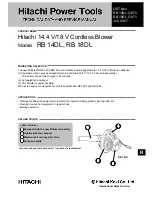
59
The main brush sweeps dust and refuse into the bin at the rear of
the motor-sweeper.
Warning!
Never sweep up string, wire, etc., which can
become entangled in the brush and damage the
bristles.
Adjusting the main brush
The main brush is raised and lowered by lever 2, fig. 3.
The main brush is mounted in a floating mechanism.
The main brush should just touch the floor, leaving a trace 3 cm wide
when it rotates (fig.13).
If the main brush leaves lines of dirt, it has worn down and must be
lowered. Proceed as follows to lower the main brush:
1. Undo the nut 2 fig. 12
2. Turn the knob 1 anti-clockwise until the trail left by the main
brush measures about 3 cm.
3. Retighten
thenut
2.
4. Check the width of the trace as shown in fig. 13.
Checking tension and replacing the
belt of the main brush (fi g. 11)
Every 100 - 150 hours work, check the condition of the primary bru-
sh drive belt 6.
Belt tension is registered by tensioner 5.
If the belt 6 is visibly worn fit a new belt as follows (fig.11):
-
Remove the right-hand side cover 1.
-
Back off the belt stretcher 2 of the transmission belt 3.
-
Remove the transmission belt 3 from the pulley 4.
-
Back off the belt stretcher 5 of the main brush drive belt 6.
-
Replace the main brush belt 6.
-
Tension the belt 6 using the belt stretcher 5.
-
Replace the belt 3 on the pulley 4.
-
Tension the belt 3 using the belt stretcher 2.
-
Replace the side cover 1.
Warning!
When the belt is replaced, the brush drive belts 3
and 7 (fi g. 11) should also be checked.
If belts show signs of wear, replace them to avoid
further down-times for more dismantling of parts.
El cepillo central es la pieza que carga la basura en el contenedor
posterior.
Atención!
No recoger nunca cuerdas, alambres, etc. puesto
que podrían enrollarse en el cepillo y deteriorar las
cerdas.
Regulación del cepillo central
Para levantar y bajar el cepillo central hay que accionar la palanca
2 (Fig. 3).
El cepillo central está montado en un mecanismo flotante.
El cepillo central sólo debe rozar el suelo, dejando una marca de 3
cm de ancho a lo largo de su trayecto (Fig. 13).
Cuando el cepillo central deja restos de suciedad durante su funcio-
namiento, debe bajarse regulándolo de la siguiente manera:
1. Aflojar la contratuerca 2 (Fig. 12).
2. Girar el pomo 1 hacia la izquierda hasta que la marca del
cepillo central sea de unos 3 cm.
3. Volver a apretar la tuerca 2.
4. Comprobar la marca (véase Fig. 13).
Tensado de la correa 6 de accionamiento del cep-
illo central y sustitución (Fig. 11)
Cada 100 - 150 horas de funcionamiento comprobar la tensión y el
grado de desgaste de la correa 6. La tensión se regula mediante el
tensor de correa 5.
Si la correa 6 está desgastada, sustituirla de la siguiente manera
(Fig. 11):
-
Desmontar la tapa lateral derecha 1.
-
Aflojar el tensor 2 de la correa de transmisión 3.
-
Quitar la correa de transmisión 3 de la polea 4.
-
Aflojar el tensor de correa 5 de la correa de accionamiento
del cepillo central 6.
-
Sustituir la correa del cepillo central 6.
-
Tensar la correa 6 con el tensor de correa 5.
-
Volver a montar la correa 3 en la polea 4.
-
Tensar la correa 3 con el tensor 2.
-
Volver a montar la tapa lateral 1.
Atención!
Cuando se sustituye la correa, comprobar también
las correas de accionamiento de los cepillos 3 y 7
(Fig. 11).
Si las correas están deterioradas, sustituirlas a fi n
de evitar pérdidas de tiempo con otros desmontajes
de piezas.
ATOM
PLUS
Содержание 37.00.174
Страница 2: ...WWW RCM IT RCM ...
















































